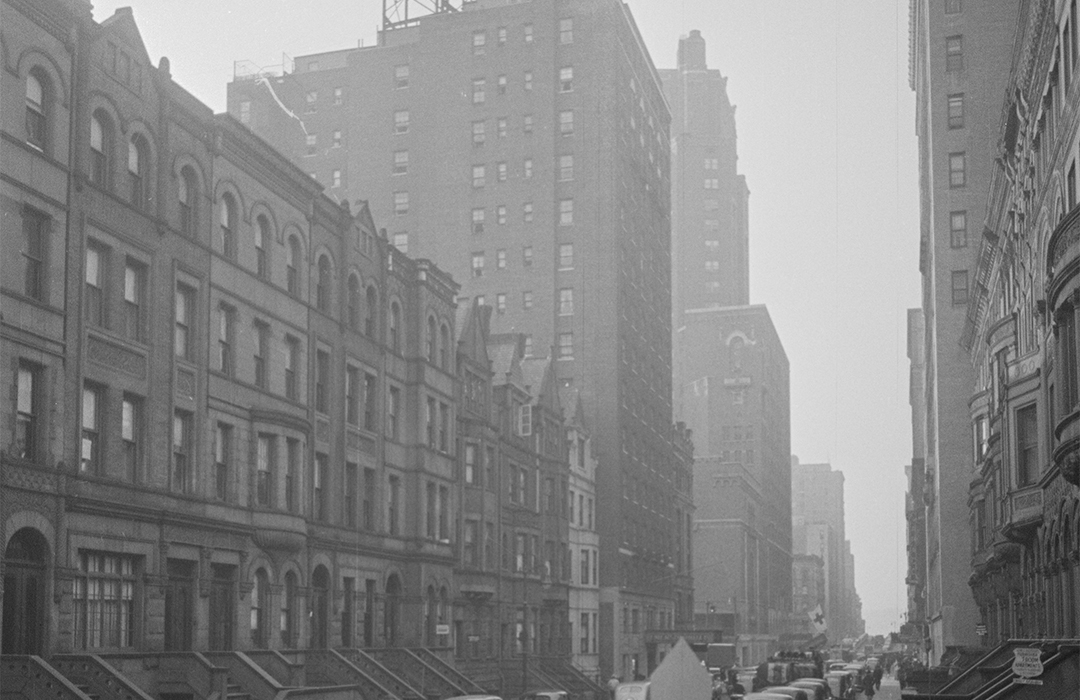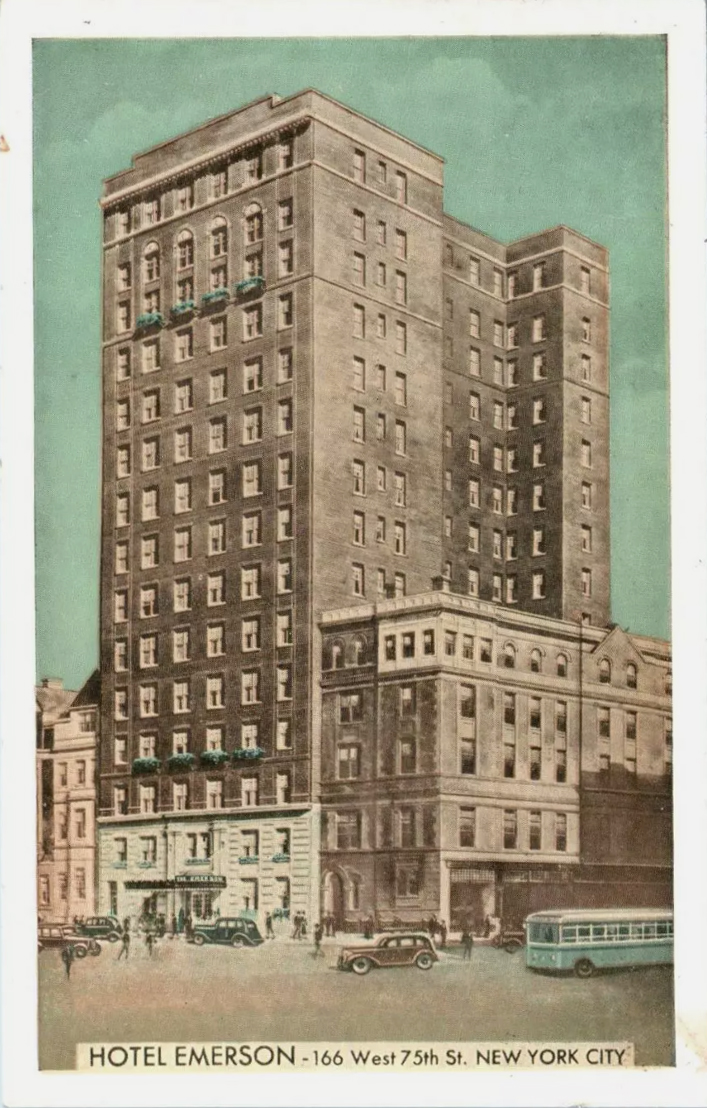
Hotel Emerson — 164-168 West 75th Street
by Tom Miller
On January 19, 1922, the New York Herald reported, “Plans were filed yesterday for a fifteen story non-housekeeping apartment house…at 164 to 168 West Seventy-fifth street for James B. Booth, head of the 166 West Seventy-fifth Street Corporation.” (Non-housekeeping apartments had no kitchens.) The New York Times said that the Emerson Hotel would be ready for occupancy by October 1, 1922, adding, “It will be a noteworthy addition to the L. Marshall Thompson chain of hotels.” Architect Robert T. Lyons estimated the cost of construction at $500,000—the equivalent of $8.73 million in 2023.
The Emerson Hotel opened only a few weeks past schedule. Lyons’s Colonial Revival design included a two-story limestone base with paired pilasters that flanked the entrance. The upper floors were clad in variegated brown brick diapered in a diamond pattern, the somewhat bland façade enlivened with iron balconies at the fourth and thirteenth floors, and arched tympana above the four central openings of the fourteenth.
The opening announcement on October 29 boasted “comfort without extravagance,” and called the Emerson the “acme of American Plan hotels.” (The American Plan included meals with the room rent.) The proprietor, L. Marshall Thompson, made it clear that this was not a residential hotel, the ad noting, “Leases only for periods of six months to one year,” and providing a rent schedule only by the week.
That all changed two years later when Modern Hospital announced in April 1924:
The Emerson Hotel, a fourteen-story [sic] structure at Seventy-fifth Street, near Columbus Avenue, New York, has been sold to the Physicians’ Medical Company, which will remodel the building into a hospital. The hotel contains 280 rooms.
It did not take the investors long to rethink their plan. A new corporation, the Physicians Medical Hotel Co., Inc. was quickly formed and three months after Modern Hospital’s article, the United States Investor reported that the Emerson Hotel was being converted to a residential hotel. “We understand that this type of hotel is practical and has proved profitable in other cities,” said the article.
Instead of responding to her husband’s presence with shock, Edna Freeman “sneered at him”…
An advertisement in The New York Times on March 22, 1925 called the Emerson Hotel, “A new and superior residential hotel with every convenience and service.” The apartments ranged from one- to three-room suites and came with yearly leases. There was now a ground floor restaurant, The Emerson, “famous for its excellent cuisine and modest prices,” said the ad. Also on the ground floor was a medical office, available for lease to a dentist or doctor.
In 1926 newlyweds Frank and Edna Freeman (a former Ziegfeld Follies showgirl) moved into the renovated hotel. In the fall of 1927, Frank became suspicious when he found several unidentifiable keys among Edna’s possessions. He had duplicates made, then hired private detectives to follow her. They told him that she was seeing at least one other man who lived on Madison Avenue.
In the early hours of December 6, 1927, Freeman and a friend, Robert W. Tolton, accompanied the detectives to 517 Madison Avenue. They went from apartment to apartment, trying keys, until finally one worked. The group quietly opened the door. A man was asleep on the sofa. The New York Sun reported, “Without disturbing him, the intruders tiptoed into the bedroom, where Freeman found his wife with another man.”
Instead of responding to her husband’s presence with shock, Edna Freeman “sneered at him,” according to the article. Enraged, Frank picked up a penknife and stabbed his wife repeatedly in the throat and breast. Now awake, the man on the sofa ran to the street to find a policeman. Edna’s lover, too, fled the apartment, but unlike Gordon Fisher, he did not return. The Sun ran the headline, “Stabbed Wife Lies Near Death,” and reported that Freeman had been arrested for assault.
Just over a week later, Edna had recuperated enough to be released from the hospital. She declined to press charges of felonious assault, but her husband was less forgiving. His lawyer asked the court on December 15 for “the arrest of Mrs. Freeman and Henry W. Livermore, in whose company she was alleged to be in an apartment at 517 Madison avenue when her husband and private detectives burst in early on the morning of December 6.” And there was more drama. Edna had obtained a summons against the Hotel Emerson, “which she said was holding her trunks on the order of her husband.”
Margarete Dessoff, who lived here at the same time, possibly disturbed the peace of her neighbors by less volatile activities. She was the director of the Adesdi Chorus of Women, and on October 7, 1927, The Standard Union announced that her apartment would be the scene of auditions for new members.
Model Charlotte Burke, who lived in the Emerson Hotel in 1929, was seeing matinee idol Kenneth Harlan. The handsome motion picture actor was a ladies’ man who would eventually marry nine times. But it was only his last wife, former Ziegfeld Follies showgirl Flo Hart, that Charlotte Burke would have to be concerned with. On August 21, Flo Hart and her roommate, Alice Vail (described by The Evening Post as “a hostess), knocked on Charlotte’s apartment door. When she opened it, they attacked. A week later, on August 27, The Evening Post reported that Charlotte was still in the Medical Arts Sanitarium “with a fractured rib, cuts on the face and scalp and other bruises.”
To attract tenants in the warm months, the Hotel Emerson opened a roof garden, common in the early 20th century. An advertisement in 1930 listed summer rates that ranged from $75 to $100 per month, or about $1,750 for the more expensive two-room suites. The Emerson Restaurant was touted in 1938 as offering “delicious dishes prepared by a former chef to a king.” Luncheon cost 50 cents and dinner 65 cents.
A renovation in 1949 resulted in space on the ground floor for the Manhattan School of Dental Technicians. It remained into the early 1950s.
The Emerson Hotel was the target of crafty thieves early in the morning of June 12, 1952. Three men entered the lobby at 4 a.m. with hats pulled over their faces and revolvers drawn. They “imprisoned the night manager and an elevator operator in a room and went to work,” reported The Daily Argus. They had carefully planned out their scheme. One took over the telephone switchboard, another the elevator, and the third ran the desk.
To attract tenants in the warm months, the Hotel Emerson opened a roof garden, common in the early 20th century.
The crook who manned the switchboard was well prepared. He followed the posted schedule and made calls to awaken guests at the appointed times. The Long Island Star-Journal said, “the switchboard substitute and the [elevator] operator played their roles to perfection. There was only one change in routine.” That change was that when guests descended in the elevator, they were taken into the side room, relieved of their cash and jewelry and added to the growing number of prisoners. The Star-Journal added, “So was each homecoming guest similarly treated.” After three hours, the bandits left. They had stolen $3,000 in cash and jewelry from the 25 people locked in the room.
In 1959 the hotel’s name was changed to the Hotel Lincoln Square. By the third quarter of the century, things had drastically declined. On December 5, 1975, The New York Times reported, “Margaret T. James, 31, was fatally bludgeoned…in her ninth-floor room at the Hotel Lincoln Square, 166 West 75th Street. An acquaintance of Miss James is being sought for questioning.” And two months later, on February 11, 1976, the newspaper reported, “A man tentatively identified as Vincent Donahue, assistant executive secretary of Actors Equity, was found stabbed to death in the bathtub of his room at the Lincoln Square Hotel.”
A renovation in 1976 resulted in two commercial spaces on the ground floor. In 1981 one was the headquarters of The Vet Center Counseling Service for Vietnam Era Veterans. Called a “storefront counseling program,” it was one of 91 functioning throughout the country, operated by the Veterans Affairs Department. It operated in here at least through 1985.
The other commercial tenant was Pan Aqua Diving, Inc. a dive shop that supplied items like fins, diving masks, gloves, and snorkels. It remained as late as 1989.
In September 2002 ‘Cesca, an Italian restaurant operated by Tom Valenti and Godfrey Polistina, opened. It was a neighborhood staple for two decades. On January 17, 2023, The New York Times food critic Florence Fabricant announced that Robert Guarino and Simon Oren had taken over the space “and plan to open a seasonal Italian restaurant that nods toward California, in early fall.”
In the meantime, the building was acquired by Simon Baron Development in 2015. The firm “focuses largely on residential and mixed-use developments, particularly rentals,” according to Vivian Marino of The New York Times on December 29 that year. A renovation was completed before the end of the year. The building now offers a fitness facility, modern appliances, and a strikingly updated lobby.
Tom Miller is a social historian and blogger at daytoninmanhattan.blogspot.com



